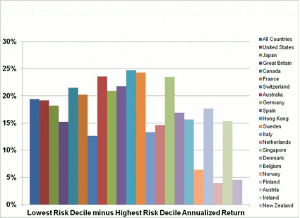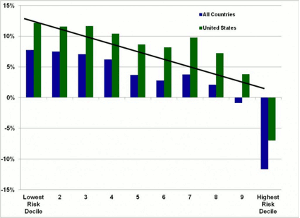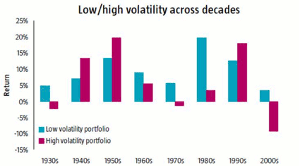Numerous studies have verified the persistence of the finding that low-volatility stocks outperform high-volatility stocks, and Rob Davenport of TradingMarkets.com outlines his steps for exploiting this anomaly to generate higher returns with lower risk.
When I began my career as a trader more than a decade ago, I often told my colleagues that as traders we got paid for taking risk. That’s what I was taught in my MBA classes—there is a fundamental tradeoff between risk and reward. Investors must take on more risk to have the opportunity for higher returns.
This bedrock principle of market relationships forms the basis of key financial theories such as the efficient market hypothesis and CAPM.
Except that it’s wrong.
Investors do not get paid for taking on more risk. The exact opposite is often true. Data shows that a portfolio of low-risk stocks has consistently out-performed a portfolio of high risk stocks on a risk-adjusted basis in the US since 1926 and in almost every market around the world.
This is called the “low volatility anomaly” in the academic world. For traders and active investors, it may be as close to a “free lunch” as we’ll ever experience.
In this article, I’ll cover seven important steps on how to create and trade a low-volatility portfolio. This approach can allow traders to benefit from the low-volatility anomaly while enhancing returns by combining short-term trading strategies with intermediate-term strategies.
The Low Volatility Anomaly
The low volatility anomaly was first formally reported in 1972 using data over the period from 1926 through 1971. In the past 40 years, numerous studies have verified the persistence of this finding that low volatility stocks outperform high volatility stocks.
The Financial Analysts Journal states that the “long-term outperformance of low-risk portfolios is perhaps the greatest anomaly in finance. Large in magnitude, it changes the basic notion of a risk-return trade-off.”
The basic study takes the universe of stocks, including de-listed stocks, for the geographic region you are studying and ranks the equities by risk. You can use either standard deviation or beta as your measure of risk and you’ll get the same result. Next, you group the stocks into 10 equal sized buckets (deciles).
NEXT PAGE: The 7 Step Low-Volatility Investing Method
|pagebreak|Each of these 10 buckets represents a portfolio of stocks. Bucket 1 is the lowest-risk stocks and bucket 10 is the 10% with the highest risk. Each month you re-rank the stocks and rebalance the 10 portfolios.
Stock Performance by Risk Group
This graph demonstrates the annualized return for each of the 10 portfolios. The lowest-risk portfolio outperformed the highest risk portfolio by an average of 19.2% over the period of 1990-2011!
This basic study has been repeated in numerous developed and emerging markets around the world.
Lowest Risk/Highest Risk International Table
Few, if any, market phenomena are so pervasive and persistent. And yet so rarely discussed or exploited.
Long-Term Low Risk/High Risk Performance
Despite this evidence, prior to 2005 very little money was invested in low-volatility strategies. Recently, however, we have seen the emergence of a number of low-volatility ETFs such as (SPLV), (XMLV), and (USMV).
These new ETFs offer a passive, buy-and-hold approach to augment investors’ portfolios. However, there can be much more effective ways for traders and active investors to benefit from low-volatility investing.
7 Steps to Successful Low-Volatility Investing
The most basic objective of market participants (both individuals and institutional investors) is to achieve higher returns while lowering risk. And there are many different ways that traders, investors, and professional portfolio managers go about trying to accomplish this objective.
Here is our methodology to creating an active, low-volatility portfolio:
The 7 Step Low-Volatility Investing Method
- Focus primarily on large-cap stocks
- Buy stocks with low volatility; and, if appropriate, sell short stocks with high volatility
- Diversify portfolios by using strategies with different hold periods (time horizons)
- Buy high momentum stocks for longer hold periods
- Buy stocks that are under-priced and sell short stocks that are over-priced when holding positions for shorter time periods
- Go to cash and/or increase short allocations in adverse market environments (i.e. use a market timing overlay)
- Hedge strategies with higher than desired volatility
By Rob Davenport of TradingMarkets.com

























